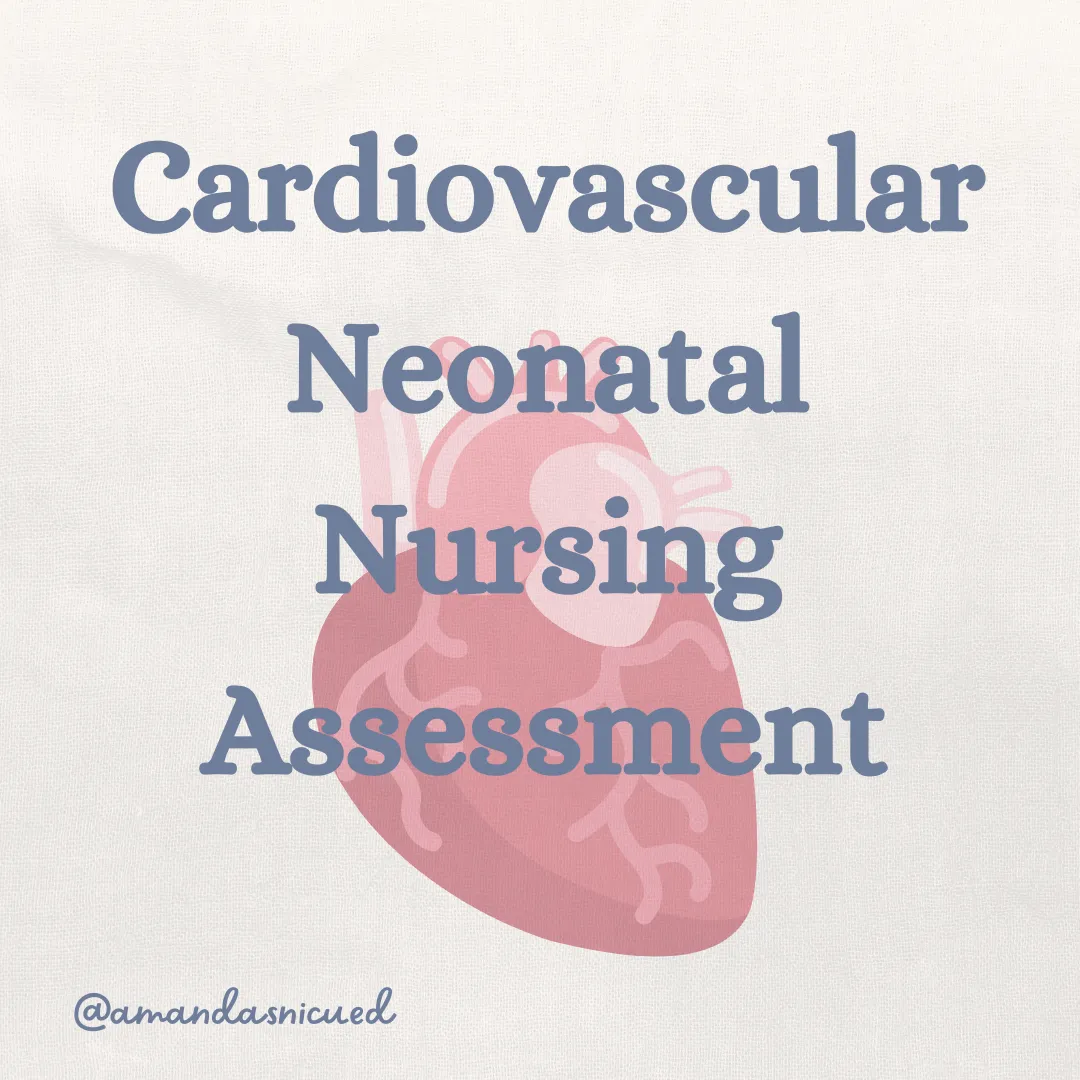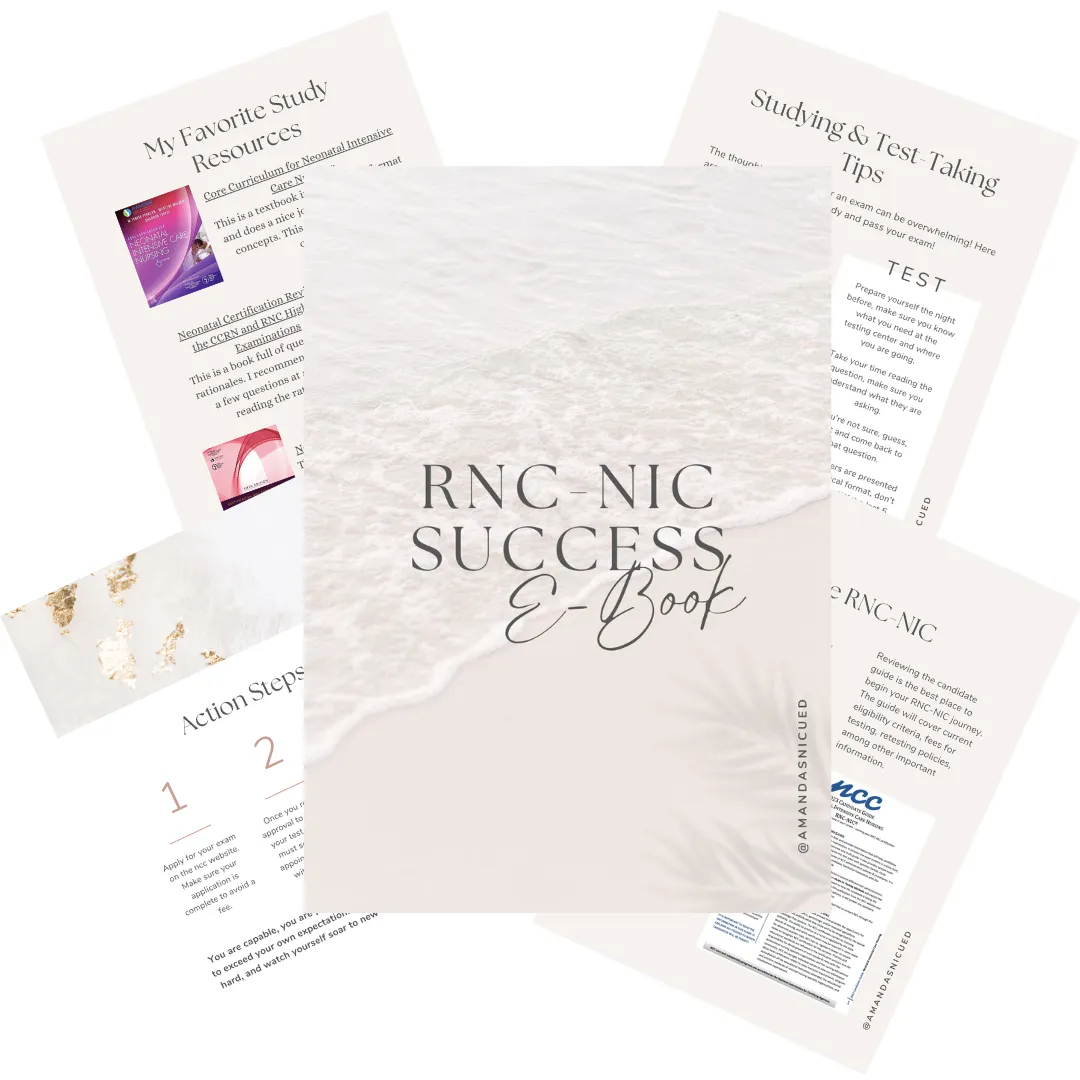
Welcome to Amanda's NICU Education




Hi! My name is Amanda. I'm a NICU nurse, Clinical Nurse Specialist, NICU Educator... basically your NICU BFF. If you want to talk NICU, I'm here for you! I love everything about NICU nursing and I'm eager to learn and share my knowledge with all my NICU friends.
I have been a NICU nurse since 2009 I am currently a Clinical Nurse Specialist in a Level IV NICU in Los Angeles.
I am passionate about educating the next generation of NICU nurses. I share my knowledge through platforms such as Instagram and Facebook and am excited to have you here on my website!
Click on the button below to sign up for my newsletter filled with NICU education and tips for all experience levels.

Not very many people love taking tests but as a self-acclaimed "forever student" who has taken (and passed) five different certification exams I am no longer afraid of tests! "Way to brag", you might be thinking but I want to help YOU pass your certification exam too!
Introducing Amanda's RNC-NIC Success digital course - your ultimate study companion!
Gain unlimited, on-demand access for life, ensuring you're primed to ace your certification exam.
I'm here to help you succeed and I can't wait for you to share with me that you PASSED the RNC-NIC EXAM!!!










Nursing Assessment: Cardiac Focus
Cardiovascular Assessment
When we are taking care of our sweet patients our assessment is of key importance. We must have a detailed understanding of what to look for, what's normal and what's abnormal with babies whether they are term or preterm.
Let's review some important aspects of our assessment including techniques and tips that I recommend to all my NICU nurse friends.

Prior to assessing our patient, collecting as thorough a history as possible will help us anticipate potential problems. Certain maternal conditions and exposures to different medications can increase the risk of a cardiovascular problem in the neonate. Maternal diabetes, for example, increases the risk of congenital heart disease by 3-4x. Specifically the most common CHDs of babies are transposition of the great arteries, VSD, cardiomyopathy and coarctation. In addition, newborns born to diabetic mothers are also at risk for hypertrophic cardiomyopathy.
Maternal systemic lupus erythematosus has been shown to increase the incidence of congenital complete heart block in the neonate. Babies with heart block will present with a low resting heart rate.
Viral illnesses, such as Rubella and cytomegalovirus, are strongly associated with a persistently patent ductus arteriosus, ASDs, and VSDs.
Family history of CHD increases the risk of CHD in the neonate, so if a parent or sibling has CHD there is a 3-5% risk of recurrence. Genetics are the single greatest risk factor for CHD.
Observation
When we begin our assessment we start with observation of the overall appearance and behavior of the baby. Observation can provide a lot of information about the baby’s current state. What’s the tone and activity? Is the baby lethargic? Restless? How does the perfusion and skin color look? Is cyanosis, pallor, mottling, or a ruddy appearance present? If the baby is on the monitor, what are the baseline vital signs? Is the baby receiving oxygen and if so, what is their oxygen saturation? Some congenital heart defects can present with cyanosis that is refractory to additional oxygen administration. It’s important to distinguish between central cyanosis and acrocyanosis. Central cyanosis is easiest to assess on the tongue and mucous membranes due to their rich vascular supply.
Pallor is concerning for compromised cardiac status and blood being shunted away from the skin to the vital organs. Mottling can also be a sign of shock, stress, or hypothermia.
In addition, we will want to observe the breathing pattern, is the baby breathing comfortably? Are they tachypneic? Comfortable tachypnea can be seen in patients with central cyanosis. The hypoxia increases the respiratory drive.
Lastly, what does the chest look like? A bounding precordium in the term baby (after the first few hours of life) can be an indication of a cardiac defect. Extremely preterm babies, however, may have an active precordium even without major cardiac issues because they have a thin chest wall.
I like to sneak the BP cuff on before I start my assessment so I can get a blood pressure while the baby is calm and resting. It’s important that we use the proper size BP cuff, a small cuff will falsely elevate the BP and a large cuff will read a falsely low BP. Normal BP is a complicated and controversial topic. Check out my blog where I dive into “normal” blood pressure in newborns.
Check out my blog on blood pressure
Auscultation
After observation we will auscultate the heart sounds, rate, and rhythm. This is best done when the newborn is calm and quiet. A normal heart rate should be around 120-140 bpm while at rest in the term neonate and may be above 170 when the baby is active or crying. Premature babies typically have a slightly higher heart rate compared to term infants.
Bradycardia can be commonly seen in the NICU, and is defined as a heart rate <80 bpm. Bradycardia can be elicited by different stimuli including suctioning, stooling, and even yawning due to the vagal reflex. Premature babies can often have episodes of bradycardia due to apnea of prematurity.
Tachycardia may be seen as well, and is a heart rate greater than 180-200 bpm. This can also be elicited with different stimuli including crying, feeding, activity, or fever.
Arrhythmias are also seen in neonates in the NICU. Supraventricular tachycardia (SVT) is the most common tachydysrhythmia in newborns (I would know that for the certification exam). SVT is characterized by a sudden increase in HR with a regular R to R interval. We can try to convert the baby back to sinus rhythm by providing vagal maneuvers such as suctioning or ice to the face. If those don’t work and the baby is hemodynamically unstable we would need to give adenosine by rapid IV push or convert by synchronized cardioversion.
When we are auscultating we also need to note the rhythm and regularity. If an arrhythmia is suspected an ECG should be obtained.
We are also listening closely for the specific heart sounds. S1 is heard during the closure of the mitral and tricuspid valves. S2 is heard during the closure of the aortic and pulmonary valves. Extra heart sounds (S3) may be heard when there is increased flow across the AV valves. It may be commonly heard in premature infants with a patent ductus arteriosus or in the newborn with congestive heart failure (though this is rare). A fourth heart sound (S4) is rarely heard in neonates.
Murmurs are auscultated when there is turbulent blood flow and can be described as innocent or pathologic. Listening for murmurs takes a lot of practice and skill. One must assess when the murmur is present. Is it during systole or diastole? Or is it continuous through both? We also want to grade how loud the murmur is. Grade I is considered barely audible, whereas grade VI is extremely loud. The absence of a murmur does not mean heart disease is not present.
Auscultation of a bruit over the liver or the fontanelle is an indicator of an arteriovenous malformation. People may look at you funny if you are putting your stethoscope over the fontanelle but if you hear a bruit you just caught a major issue for that baby.
Palpation
Last we will palpate the pulses, noting the rate, rhythm, and volume of the pulses. Pulses can be characterized as full or bounding (3+), Normal (2+), thready and weak (1+), or absent (0). At minimum the brachial and femoral pulses should be palpated with each full assessment. The right brachial and femoral pulses should also be assessed simultaneously. Absent or weak femoral pulses in comparison to a normal or strong brachial pulse is abnormal and could be a sign of decreased aortic blood flow.
Bounding pulses can be a sign of a patent ductus arteriosus or other aortic runoff lesion (e.g. truncus arteriosus, aortic regurgitation, or AV fistula).
Weak or absent pulses can occur when there is low cardiac output, shock, and/or myocardial failure and should be investigated.
You may also palpate the apical pulse at the 4th intercostal space to the left of the midclavicular line. It is beneficial to identify the apical pulse (and point of maximal impulse) because in some emergencies (tension pneumothorax for example) this will shift and is an important finding.
Capillary refill time is a quick assessment of perfusion. Normal capillary refill time should be brisk, less than 3 seconds. A slow capillary refill time is concerning for poor perfusion and requires investigation.
When palpating the abdomen you may feel hepatomegaly if a baby has congestive heart failure. Palpating the liver 3cm below the right costal margin is a good indicator of right sided heart failure in the term baby. Are you palpating for the liver with each assessment?

I hope this review was helpful when considering your assessment techniques and specifics to look for in your cardiovascular assessment. Next time let’s review some of the most common congenital heart defects.
Wishing you all the best!
Amanda xoxo
Missed my other newsletters? Click here to read them!
Let's Study Together! Join my Certification Course
References:
Vargo, L. (2016) Cardiovascular assessment in Tappero & Honeyfield Physical Assessment of the Newborn (5th Ed). Springer
Wright, K. & Hoffman, J. (2020). The Cardiac System in Koehn's Neonatal Nurse Practitioner Certification Intensive Review: Fast Facts and Practice Questions. Springer

December 2023 Certification Review Webinar
NICU Certification Review



Ready to kickstart your journey to becoming a certified NICU nurse?
Look no further!
Grab my FREE E-Book packed with essential study and test-taking strategies for the RNC-NIC.
In the E-Book I give you the resources you need including the link to access the candidate guide, several types of books to study from, some of my favorite strategies, an outline of the content you should review, and a blank calendar for you to make your study plan!
Frequently Asked Questions About the RNC-NIC exam

What is the RNC-NIC?
The RNC-NIC is a competency-based exam that tests the specialty knowledge of nurses in the United States & Canada who care for critically ill newborns and their families.
The RNC-NICU is a nationally recognized certification that recognizes the registered nurse for their specialty knowledge and skill.

Who can take the RNC-NIC exam?
Nurses can take this exam after a minimum of two years experience in the NICU caring for critically ill newborns and their families.

Which books should I use?
I'm glad you asked! There are many excellent books to help you prepare for the RNC-NIC, I gathered ande describe each of them for you in my FREE e-book.
Is there a course to help me study?
Yes! Many hospitals host their own certification course and there are a few online courses. See my RNC-NIC test taking tips E Book for more information
What happens if I don't pass the exam?
If you don't pass the exam on your first try you can try again after 90 days. You will have to reapply after 90 days and pay a retest fee. There is no limit to the number of times you can take the exam (however a candidate can only sit for the exam twice per year).

Can I make more money if I take the RNC-NIC exam and get certified?
Yes! Many hospitals provide a raise or a bonus for nurses with specialty certifications. Hospitals also typically hire at a higher base salary when nurses have a certification.

Find me @amandasnicued on these channels or Email me
hey nurses don't miss out
© Copyright 2024. AmandasNICUEd. All rights reserved. | Terms & Conditions | Privacy Policy Contact: [email protected]

